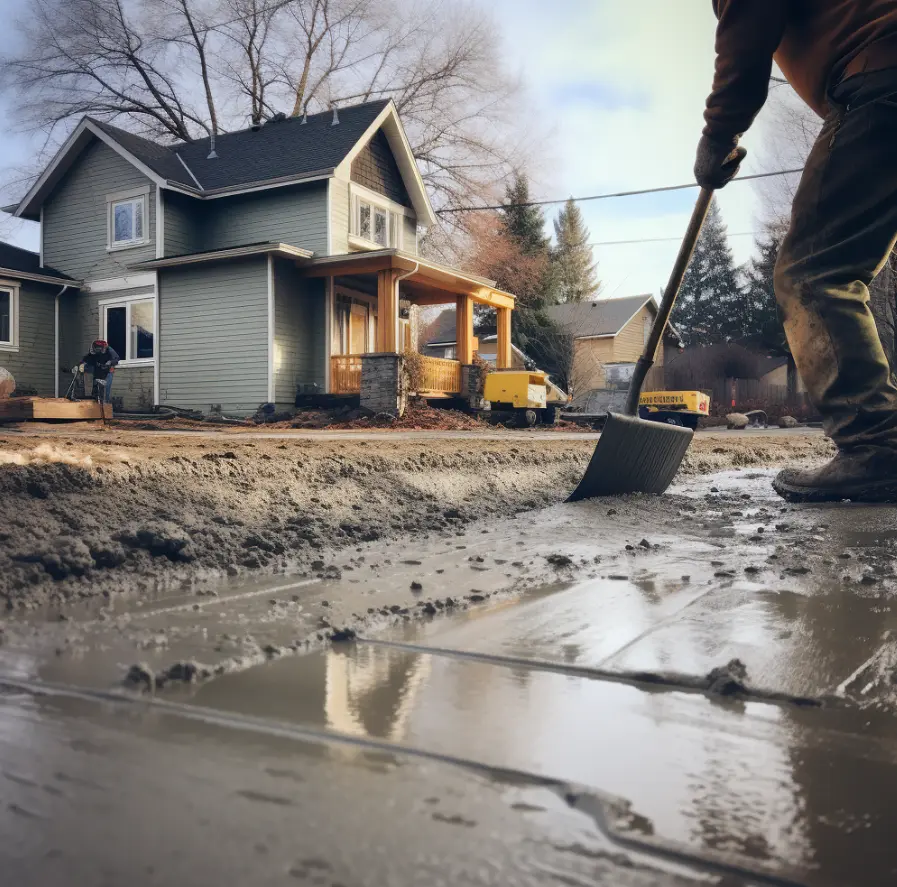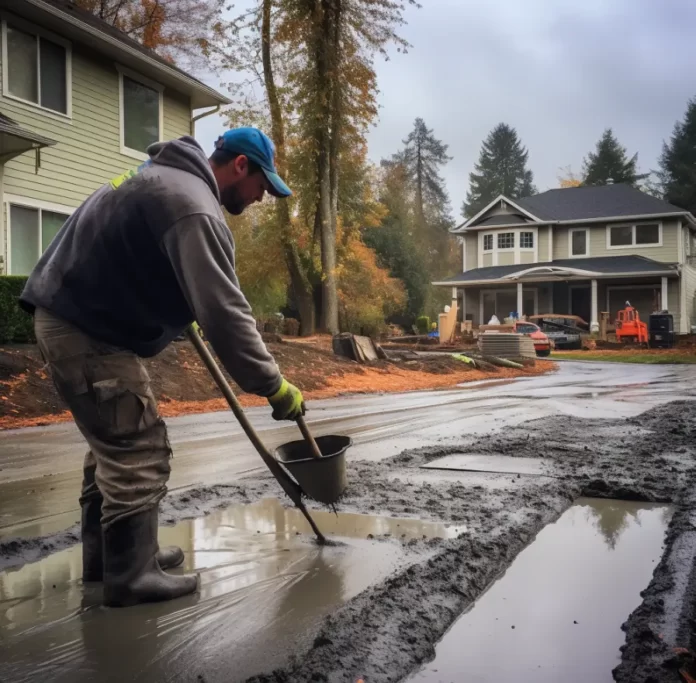Table of Contents
How close to my property line can i pour concrete?
When pouring concrete close to your property line, it is important to comply with local building codes and zoning laws, which can vary depending on your location.
- Generally, most municipalities require a setback distance of at least 2-3 feet from the property line for any construction, including concrete pouring.
- However, some areas may have different regulations, so it is essential to check with your city or county planning department to determine the required setback distance in your area.
- Additionally, it is recommended to stay at least three feet away from the property line when pouring concrete.
- Pouring concrete too close to the property line can result in damage to your property or infringing on your neighbor’s property, so it is important to be cautious and comply with any regulations that may apply.
- It is also advisable to hire a professional concrete contractor who understands the codes and regulations unique to your area and to discuss property line requirements and permitting before beginning the project.
What are the regulations for pouring concrete in a residential area?
Compliance with local building codes and zoning laws:
- Ensure that your project complies with local building codes and zoning laws, which may vary by location.
- These regulations are in place to ensure the safety, legality, and adherence to local guidelines.
Setback distance:
- Most municipalities require a setback distance of at least 2-3 feet from the property line for any construction, including concrete pouring.
- Check with your city or county planning department for specific setback distance requirements in your area.
Soil conditions:
- The fill soils supporting footings and foundations must be designed, installed, and tested according to accepted engineering practices.
- Gravel fill used for footings should comply with Section R403, and the area within foundation walls should be free of vegetation, topsoil, or foreign material.
Concrete strength:
- All concrete used in precast concrete foundations must have a minimum compressive strength of 5,000 psi at 28 days.
- Materials used in concrete production and testing should comply with applicable standards listed in Chapters 19 and 20 of ACI 318 or ACI 332.
Thickness of the slab:
- The slab should be at least 3.5 inches thick, and in some cases, it may need to be thicker for expansive or challenging soil conditions.
Compaction and base course:
- Fill material should be compacted and should not exceed 24 inches for sand or gravel fill or 8 inches for earth fill.
- A base course of 4 inches of clean, graded sand, gravel, crushed stone, or slag is required under the slab unless the existing soil is exempted by a soils report.
Vapor retarder:
- A vapor retarder of at least 6 mil thickness should be installed between the base course and the concrete slab.
Reinforcement:
- Reinforcing materials should be positioned in the top 1/2 to 1/3 of the depth of the concrete slab throughout the pour.
Process for obtaining a permit to pour concrete near the property line

Obtain the Permit:
- Submit all required documents and information to the local building authority.
- Provide project details, location, size, scope, and plans or drawings.
- Pay any applicable permit fees as determined by your location and project cost.
- Wait for the application to be reviewed and processed by the local authorities.
- This may involve inspections or further inquiries.
- Once approved, you will receive the concrete pouring permit, which will outline specific project requirements and conditions.
Comply with Regulations:
- Ensure that the concrete pouring project adheres to local building codes and zoning laws.
- Regularly inspect and monitor the project to maintain compliance.
- Address any issues or concerns promptly and make necessary adjustments as per local regulations.
- Consult with a professional contractor and local building officials throughout the project to ensure ongoing adherence to all regulations and safety measures.
what are the consequences of pouring concrete too close to the property line?
Consequences of Pouring Concrete Too Close to the Property Line:
Legal Issues:
- Pouring concrete in violation of setback rules or other municipal laws can be illegal.
- This may result in fines, penalties, or legal actions initiated by regional authorities or concerned parties.
Conflicts with Neighbors:
- Pouring concrete that encroaches on your neighbor’s property can lead to disputes and strained relationships with neighbors.
Structural Concerns:
- Concrete is a heavy material and can cause problems like cracks, shifts, or subsidence in nearby buildings, fences, or walls, especially if it’s not properly installed or if the soil conditions are unstable.
- Improper drainage can result in water pooling, erosion, and potential structural damage.
Recommendations to Avoid Consequences:
Compliance with Local Building Codes and Zoning Laws:
- Ensure that your concrete pouring project adheres to local building codes and zoning laws, which can vary by location.
Maintain Adequate Setback Distance:
- It is recommended to stay at least three feet away from the property line when pouring concrete. This helps reduce the risk of encroachment and associated issues.
Hire a Professional Contractor:
- Engage a professional contractor with experience working in tight spaces and a strong understanding of the codes and regulations specific to your area.
- A professional can help you navigate regulatory requirements and secure any necessary permits or inspections, ensuring a smoother and compliant project.
How to determine the property line for pouring concrete?
To determine the property line for pouring concrete, you need to know the boundary lines of your property.
- You can find this information on a plat map or deed.
- If you are unsure of where your property line is, you can contact your local jurisdiction for assistance.
Once you know your property lines, you need to determine how close to the line you can pour concrete.
- There are a few factors to consider, including local building codes and zoning laws, which can vary depending on your location.
- Generally, most municipalities require a setback distance of at least 2-3 feet from the property line for any construction, including concrete pouring.
- However, some areas may have different regulations, so it is essential to check with your city or county planning department to determine the required setback distance in your area.
To ensure that you are not encroaching on your neighbor’s property or causing any damage, it is important to hire a professional contractor who has experience working in tight spaces.
- They can also help you navigate any regulatory requirements and obtain any necessary permits or inspections.
Fees associated with obtaining a permit to pour concrete near the property line
The fees associated with obtaining a permit to pour concrete near the property line can vary depending on your location. In some areas, you may not need a permit if the concrete installation is at or just above grade. In other areas, you may need to obtain a permit for any construction, including concrete pouring. The fees for obtaining a permit can also vary depending on the estimated cost of the project.
Here are some examples of permit fees for pouring concrete in different areas:
City of St. Louis:
- Fees are based on the total estimated project cost.
- Range from $44 for projects costing up to $1,000 to $10 per thousand estimated construction cost or fraction thereof for projects over $3,000.
City of Dearborn:
- Private property permit fees are based on square feet.
- Cost $3.60 per 100 square feet, with a minimum fee of $50.
County of Santa Clara:
- Building permit fees for concrete work are based on the valuation of the project.
- Range from $150 to $1,000 or more.
City of Lee’s Summit:
- Permit fees for concrete work vary depending on the type of project and the estimated cost of the work.
To determine the specific permit requirements and fees for pouring concrete near your property line, it is essential to check with your local building authority. They can provide you with the most accurate and up-to-date information for your specific location.
Common mistakes to avoid when pouring concrete near the property line
- Underestimating the amount of concrete needed
- Ordering the wrong kind of concrete
- Improper installation of concrete forms
- Using the wrong cement-to-water ratio
- Waiting too long to level after pouring
- Removing the forms too soon
- Pouring concrete that is too wet or too dry
- Pouring concrete that is too thin
- Inaccurate or weak forming
- Using an incorrect water/cement ratio
- Overworking the concrete
- Failing to take weather into account
To avoid these mistakes, it is advisable to hire a professional concrete contractor who understands the codes and regulations unique to your area and to discuss property line requirements and permitting before beginning the project. Proper preparation, installation, and aftercare for concrete are essential to ensure that the project is as durable as you expect and lasts a long time.
Conclusion
In conclusion, the proximity to your property line for pouring concrete is subject to local building codes, zoning regulations, and a variety of factors. Maintaining a setback distance of at least 2-3 feet is a common requirement, with variations by location. To avoid potential pitfalls such as legal issues, disputes with neighbors, and structural problems, it is crucial to adhere to regulations, consult with professionals, and obtain the necessary permits. By taking these precautions and making informed decisions, you can ensure a successful and trouble-free concrete pouring project near your property line.
